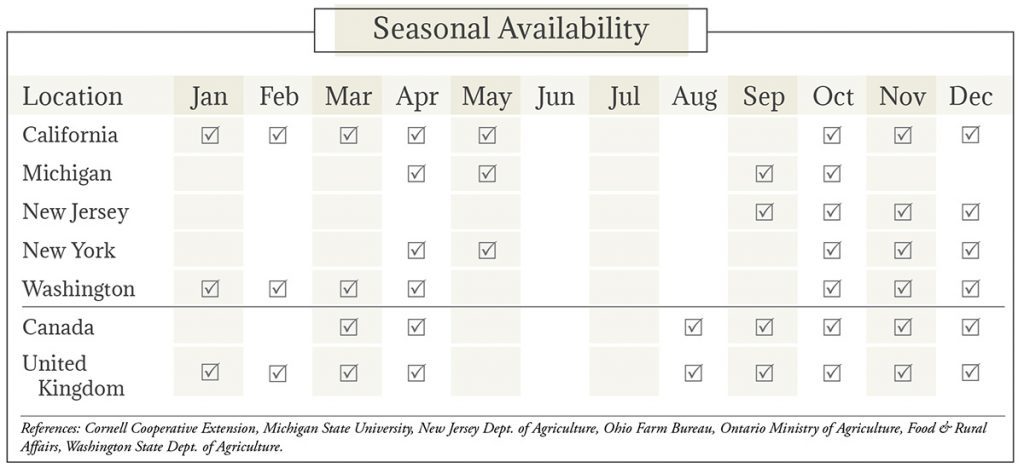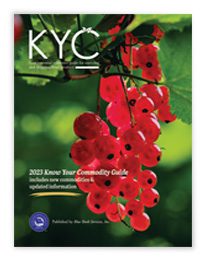Parsnip Market Summary


Image: Baloncici/Shutterstock.com
Parsnip Market Overview
Native to the Mediterranean, parsnips (Pastinaca sativa) were popular with the ancient Greeks and Romans and the root vegetable became a mainstay of European diets. They were eventually brought to North America by British settlers as early as the 1600s. An herbaceous biennial plant, parsnips are generally grown as an annual. The vegetable’s edible taproot looks like a large white carrot. Though carrots and parsnips both belong to the Apiaceae or Umbelliferae family, parsnips are sweeter. Other members of the flowering plant family include celery, parsley, dill, coriander, and fennel. Parsnips are considered a winter vegetable and taste best when exposed to freezing temperatures, which convert starch to sugar. Distinction should be made between cultivated parsnips, grown for consumption, and wild, cow, and giant hogweed parsnip varieties, which are classified as invasive weeds. Though the root of the wild parsnip, in particular, is edible, and it may look and smell like a cultivated parsnip, it produces a sap that can be harmful to human skin.
Types & Varieties of Parsnips
Parsnips are divided into three types, based on shape. Bulbous parsnips are rounder, squatter, and tend to be used consistently in food processing. Wedge parsnips are similar in shape to bulbous but are longer, resembling a carrot. Bayonet parsnips tend to grow long and narrow. There are dozens of varieties of parsnips, for commercial and home garden use. They range from Albion, All American, Archer, and Cobham Marrow to Harris Model, Viking, Warrior, and White Spear. Cultivars are differentiated by whether they are heirloom or hybrid. Heirloom cultivars, such as Hollow Crown or Student, are open-pollinated, allowing more genetic diversity in parsnip growth and letting sowers save seeds from year to year. Hybrid cultivars, such as the popular Gladiator or Javelin, are blended genetically. Hybrids tend to be more resistant to some diseases, such as canker. Newer varieties include Andover and Lancer.

The Cultivation of Parsnips
A cool season crop, parsnips can be planted in spring and harvested in fall before the last frost. Seeds should be liberally distributed, in rows, in sandy or loamy well-drained soil. Moderately cool temperatures, sun, and adequate moisture will help with spotty germination. Unlike carrots, plants do not tolerate high heat as warmer temperatures will cause bolting. Once seeded, parsnips can take up to 4 months to fully develop. At harvest, roots will likely be 1 to 2 inches in diameter and 7 to 8 inches in length. Parsnips taste sweetest if tops have frozen and roots have been exposed to temperatures under 40°F. After harvest, tops should be removed, and roots thoroughly washed before storage.
Pests & Diseases Affecting Parsnips
Aphids extract juices from leaves or stems, causing yellowing, and leave a sugary honeydew that can lead to mold. Control methods include both natural predators and chemical sprays. Carrot rust flies are bluish-black insects that lay eggs near the root; as larvae mature, they burrow inside the root, killing young plants and scarring mature plants. Row covers can be helpful in keeping the pests at bay before eggs are laid, as most pesticides do little to deter flies. Other harmful pests include armyworms, cutworms, parsley-worms, and webworms, black swallowtails, carrot weevils, leaf hoppers, leafminers, and mites. Parsnip canker, alternately known as Itersonilia canker or black canker, causes superficial black, brown, or purple cankers on roots that can lead to rot. Crop rotation and planting resistant varieties such as Andover can help, as there are no effective pesticides or fungicides. Blight occurs when soilborne bacteria enters plants through existing wounds. Symptoms include discoloration and rotting of both the crown and the root, which can lead to petiole collapse and soft rot. Crop rotation can keep bacteria from building up in the soil. Other diseases of concern include cavity spot, damping off, downy and powdery mildew, root and crown rot, root-knot nemadoes, and aster yellows, which causes characteristic yellowing of leaves, deformed flowers, and stunts growth.Storage & Packaging of Parsnips
Freezing is generally preferred for storing parsnips. Roots may be stored in 95 to 100% relative humidity at 32°F for up to 6 months. With bulk storage, parsnips can be kept in pallet bins with other crops such as tomatoes, cabbages, parsley, and carrots. They should not be stored with crops such as cantaloupes or apples, which produce ethylene as this will cause bitterness. References: Alberta Agriculture & Rural Development, Cornell University, Michigan State University, Ontario Ministry of Agriculture, Food & Rural Affairs, Texas A&M AgriLife Extension, University of Georgia Extension, University of Illinois Extension, Washington State University Extension.Grades & Good Arrival of Parsnips
Parsnip grades are divided into U.S. No. 1 and U.S. No. 2. For both grades, diameter should be a minimum of 1.5 inches. For U.S. No. 1, tops should have leaves pruned to within .75 inches from the crown and parsnips should be smooth, not misshapen, free from dirt, firm, and without roots. If blemishes exist, they should not materially alter the appearance. For U.S. No. 2, parsnips should be well-trimmed like U.S. No. 1, not badly misshapen or damaged and free from any defect (rot, insects, bruises, discoloration) which significantly affects appearance or edibility.| U.S. Grade Standards | Days Since Shipment | % of Defects Allowed | Optimum Transit Temp. (°F) |
| 10-5-1 | 5 4 3 2 1 | 15-8-3 14-8-3 13-7-2 11-6-1 10-5-1 | 32° |

